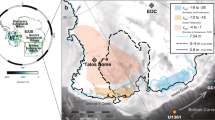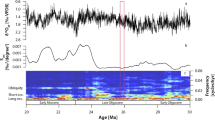Abstract
The extent of glaciation at the northern margin of the Canadian/Greenland high-latitude Arctic region over the past 30,000 years is uncertain. Geological arguments have been made for Greenland and Ellesmere Island ice sheets that coalesced to block the Nares Strait1, and for restricted ice sheets on the two islands2 leaving the strait open, as it is today3. Distinguishing between these two possibilities would provide significant constraints on present understanding of the past circulation between the Arctic and Atlantic oceans4,5, on estimates of past ice-volume6, and on the response of the Greenland ice sheet to climate change7. Radiocarbon analyses provide dates for the deglaciation of the islands' coasts, but do not yield information on whether ice filled the strait. Here we present measurements of cosmogenic 36Cl that has accumulated in situ in erratics and glacially polished bedrock on islands within the Nares Strait. These data allow us to determine the time for which the rocks have been recently exposed to the atmosphere, and thus the age of the final deglaciation of the strait. We show that Greenland and Ellesmere ice sheets retreated from the Nares Strait about 10,000 years ago. The strait was filled with ice during the last glaciation, blocking this connection between the Arctic and Atlantic oceans, and supporting the model of extensive and long-lasting ice on land and sea in this region8,9,10,11.
This is a preview of subscription content, access via your institution
Access options
Subscribe to this journal
Receive 51 print issues and online access
$199.00 per year
only $3.90 per issue
Buy this article
- Purchase on Springer Link
- Instant access to full article PDF
Prices may be subject to local taxes which are calculated during checkout


Similar content being viewed by others
References
Blake, W. J Studies of glacial history in Arctic Canada. I. Pumice, radiocarbon dates and differential post-glacial uplift in the eastern Queen Elizabeth Islands. Can. J. Earth Sci. 7, 634–664 (1970).
England, J. Late Quaternary glaciation of the northeastern Queen Elizabeth Islands, N.W.T., Canada; alternative models. Quat. Res. 6, 185–202 (1976).
England, J. Isostatic adjustments in a full glacial sea. Can. J. Earth Sci. 20, 895–917 (1983).
Aksu, A. E. & Piper, D. J. W. Baffin Bay in the past 100,000 yr. Geology 7, 245–248 (1979).
Aksu, A. E. in Quaternary Environments: the Eastern Canadian Arctic, Baffin Bay and West Greenland (ed. Andrews, J. T.) 181–209 (Allen & Unwin, Boston, (1985).
Peltier, W. R. Mantle viscosity and ice-age ice sheet topography. Science 273, 1359–1364 (1996).
Cuffey, K. M. & Clow, G. D. Temperature, accumulation, and ice sheet elevation in central Greenland through the last deglacial transition. J. Geophys. Res. 102, 26383–26396 (1997).
Hughes, T., Denton, G. H. & Grosswald, M. G. Was there a late-Würm arectic ice sheet? Nature 266, 596–602 (1977).
Tushingham, A. M. On the extent and thickness of the Innuitian Ice Sheet: a postglacial-adjustment approach. Can. J. Earth Sci. 28, 231–239 (1991).
Blake, W. J Holocene emergence at Cape Herschel, east-central Ellesmere Island, arctic Canada: implications for ice sheet configuration. Can. J. Earth Sci. 29, 1958–1980 (1992).
Funder, S. & Hansen, L. The Greenland ice sheet—a model for its culmination and decay during and after the last glacial maximum. Bull. Geol. Soc. Denmark 42, 137–152 (1996).
Aagaard, K. & Carmack, E. C. The role of sea ice and other fresh water in the arctic circulation. J. Geophys. Res. 94, 14485–14498 (1989).
Funder, S. in Quaternary Geology of Canada and Greenland (ed. Fulton, R. J.) 743–792 (Geological Survey of Canada, Ottawa, (1989).
England, J. Advance of the Greenland Ice Sheet on to north-eastern Ellesmere Island. Nature 252, 373–375 (1974).
de Freitas, T. A. Implications of glacial sculpture on Hans Island, between Greenland and Ellesmere Island. J. Glaciol. 36, 129–130 (1990).
Blake, W. J Shell-bearing till along Smith Sound, Ellesmere Island–Greenland: age and significance. Sveriges Geologiska Undersökning 81, 51–58 (1992).
Blake, W. J, Boucherle, M. M., Fredskild, B., Janssens, J. A. & Smol, J. P. The geomorphological setting, glacial history and Holocene development of “Kap Inglefield Sø”, Inglefield Land, North-West Greenland. Meddelelser om Grønland 27, 1–42 (1992).
Reeh, N. Was the Greenland ice sheet thinner in the late Wisconsinan than now? Nature 317, 797–799 (1985).
Phillips, F. M., Leavy, B. D., Jannik, N. O., Elmore, D. & Kubik, P. W. The accumulation of cosmogenic chlorine-36: a method for surface exposure dating. Science 231, 41–43 (1986).
Phillips, F. M., Zreda, M. G., Flinsch, M. R., Elmore, D. & Sharma, P. Areevaluation of cosmogenic 36Cl production rates in terrestrial rocks. Geophys. Res. Lett. 23, 949–952 (1996).
England, J. The glacial geology of northeastern Ellesmere Island, Northwest Territories, Canada. Can. J. Earth Sci. 15, 603–617 (1978).
Taylor, R. E., Stuiver, M. & Reimer, P. J. Development and extension of the calibration of the radiocarbon time scale: archeological applications. Quat. Sci. Rev. 15, 655–668 (1996).
England, J. Glacier dynamics and paleoclimatic change during the last glaciation of eastern Ellesmere Island, Canada. Can. J. Earth Sci. 33, 779–799 (1996).
Briner, J. P. & Swanson, T. W. Using inherited cosmogenic 36Cl to constrain glacial erosion rates of the Cordilleran ice sheet. Geology 26, 3–6 (1998).
Kelly, M. & Bennike, O. Quaternary Geology of Western and Central North Greenland (Geological Survey of Greenland, Copenhagen, (1992).
England, J. Support for the Innuitian Ice Sheet in the Canadian High Arctic during the Last Glacial Maximum. J. Quat. Sci. 13, 275–280 (1998).
Phillips, F. M. & Plummer, M. A. CHLOE: A program for interpreting in-situ cosmogenic nuclide data for surface exposure dating and erosion studies. (abstr.) Radiocarbon 38, 98 (1996).
Liu, B., Phillips, F. M., Fabryka-Martin, J. T., Fowler, M. M. & Biddle, R. S. Cosmogenic 36Cl accumulation in unstable landforms, 1, Effects of the thermal neutron distribution. Wat. Resour. Res. 30, 3115–3125 (1994).
Lal, D. Cosmic ray labeling of erosion surfaces: in situ nuclide production rates and erosion models. Earth Planet. Sci. Lett. 104, 424–439 (1991).
Phillips, F. M. et al. Cosmogenic 36Cl and 10Be ages of Quaternary glacial and fluvial deposits of the Wind River Range, Wyoming. Geol. Soc. Am. Bull. 109, 1453–1463 (1997).
Acknowledgements
This work was supported by the NSF, through grants from the Geosciences Directorate (to F.M.P.) and the Office of Polar Programs (to M.Z.), and by the David and Lucile Packard Foundation, through the Fellowship in Science and Engineering (to M.Z.). AMS work was supported by the NSF (grants to D.E.). Field work was organized by J.E. and supported by the Polar Continental Shelf Project (Natural Resources Canada).
Author information
Authors and Affiliations
Corresponding author
Rights and permissions
About this article
Cite this article
Zreda, M., England, J., Phillips, F. et al. Unblocking of the Nares Strait by Greenland and Ellesmere ice-sheet retreat 10,000 years ago. Nature 398, 139–142 (1999). https://doi.org/10.1038/18197
Received:
Accepted:
Issue Date:
DOI: https://doi.org/10.1038/18197
This article is cited by
Comments
By submitting a comment you agree to abide by our Terms and Community Guidelines. If you find something abusive or that does not comply with our terms or guidelines please flag it as inappropriate.



